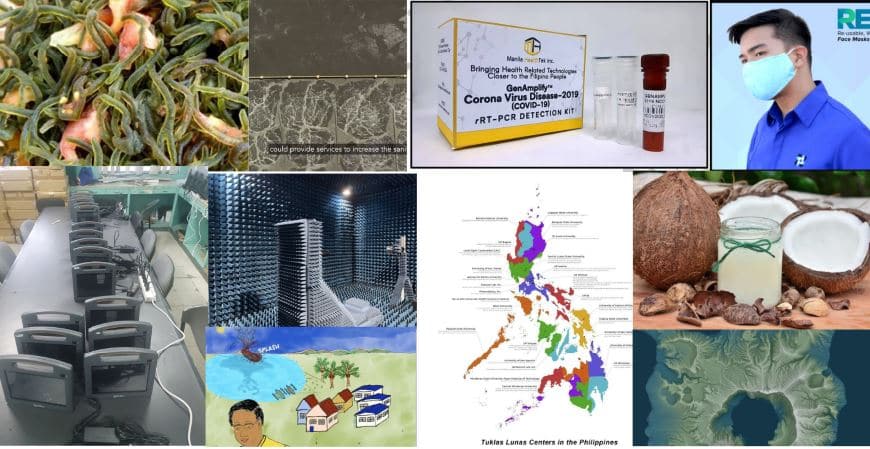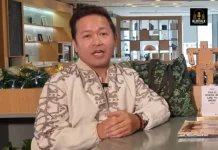
This Year Ender List of the Good News about Filipino Technology in 2020 presents the best of the ground-breaking Filipino science and technology innovations that were developed in response to the Taal Volcano eruption in January and as the world faced the coronavirus pandemic.
Filipino scientists, researchers, and engineers worked together with the Department of Science and Technology (DOST), the best Philippine universities, and private institutions to develop solutions to help the nation cope with natural disasters and the public health crisis.
The resulting researches and innovations in food, health, medical devices, and environmental science gave people hope that the country can overcome the crises.
These are the 10 Best Good News in Filipino Science & Technology for 2020 that received the most love from GoodNewsPilipinas.com readers:
10. Medicine from Philippine plants
In January, Pinoy scientists from the Tuklas Lunas program released a report on the ongoing studies on developing herbal remedies and drugs from Philippine biodiversity to produce more accessible, reliable, and affordable medicines.
Included in the report are the formulation and standardization of plant-based remedies for gout, inflammation, hypertension and blood-glucose-lowering
by the University of the Philippines Manila, Ateneo de Manila University, Pascual Lab, Inc., Pharmalytics, Inc., and Herbanext Lab, Inc., and the development of functional food and herbal drug candidates from edible mushrooms and ferns being conducted by the Central Luzon State University and Central Mindanao University.
Pinoy scientists develop medicine from local plants to heal hypertension, gout, and other ailments
9. UP scientist Mahar Lagmay’s infographics on Taal Volcano
The University of the Philippines Resilience Institute’s Dr. Mahar Lagmay went on social media to offer animated infographics to clarify circulating information on the Taal Volcano eruption of January 12 that caused confusion among the public.
The UP volcanologist himself created the easy step-by-step presentations and released them on his Facebook, Twitter, and YouTube to reach more people.
UP scientist Mahar Lagmay’s animated infographics tackle Taal Volcano eruption facts
8. University of the Philippines opens portal on Taal Volcano data
In the latter part of January, the University of the Philippines announced it was opening its Light Detection and Ranging (LiDAR) portal on Taal Volcano data, becoming the first university in Asia to offer public access to its research.
The LiDAR portal on the Taal Volcano was offered to help hasten rehabilitation efforts, marking the first time an Asian country has practiced an open data policy.
University of the Philippines opens portal on Taal Volcano data, 1st in Asia to offer public access
7. Virgin Coconut Oil derivative as COVID-19 treatment
A Filipino-developed virgin coconut oil derivative was studied as a possible treatment for COVID-19.
In January, Ateneo de Manila University professor Dr. Fabian Antonio Dayrit published his research on the potential of the antiviral activity of coconut oil’s lauric acid and monolaurin to cure viruses. The efficacy of the derivative was tested in Singapore and in Philippine hospitals. By December, the DOST reported the VCO has been found to be effective in reducing the symptoms of the coronavirus disease.
Filipino-developed virgin coconut oil derivative as COVID-19 cure tested in Singapore
6. UP wins 1st place in Space Mission Idea Contest
We may soon see Filipino-designed technology aboard the International Space Station as Filipino science researchers from the University of the Philippines Diliman as announced in January to have won First Place in the 2019 Space Mission Idea Contest at the 7th University Space Engineering Consortium-Global Meeting in Japan.
Team Philippines took the top prize in the IVA-replaceable Small Exposed Experiment Platform (iSEEP) category for their entry, the “Spectrum Monitoring from Space with i-SEEP (SMoSiS)”. SMoSiS is credited with the ability to “Capture and Map the Digital Divide from Space” with the use of radiofrequency (RF) spectrum measurements. The SMoSiS aims to provide measurement data of RF spectrum occupancy on earth to detect the presence or lack of telecommunication and broadcast services.
UP Diliman experiment wins 1st place in Space Mission Idea Contest in Japan
5. RxBox vital signs monitor for COVID-19 patients
The RxBox is a portable bedside vital signs monitoring device that can help the hospital in providing more beds with continuous vital signs monitoring and proper care for critically ill COVID-19 patients
The biomedical device was developed by a team of researchers from the University of the Philippines Manila and Diliman campuses with support from the Department of Science and Technology – Philippine Council for Health Research and Development and was first used in April at the Philippine General Hospital (PGH), a referral hospital for COVID-19 patients.
4. Washable airborne droplets-repellent cloth face masks
The face mask, called “REwear Face Mask Made Smart”, announced in March can repel airborne coronavirus droplets, is reusable, and can be washed up to 50 times. The mask has since received W.H.O. certification.
The face mask uses the Philippine Textile Research Institute (PTRI) textile-coating technology for treatment and finishing. The material of the outer layer of REwear undergoes a protective treatment that could repel airborne liquid droplets that may carry bacteria and viruses from cough and sneezes, preventing the microbes from penetrating the mask. The process does not coat the whole fabric, but only coats the fibers and allows the mask to be breathable. This feature also allows the mask to be used multiple times, freeing up the shortage, and need for more masks.
Pinoy technology produces 500,000 washable airborne droplets-repellent cloth face masks
3. First Philippine-made COVID-19 Test Kit
The first Philippine-made COVID-19 Test Kits developed at the University of the Philippines Manila in March began manufacturing in April with a second version released in July.
The GenAmplify Coronavirus Disease 2019 (COVID-19) Real-Time-PCR Detection Kits can only be used in hospitals with Polymerase Chain Reaction (PCR)-based machines also known as thermocyclers/DNA amplifiers to work and cannot be used at home. The technology is considered the gold standard in testing.
BREAKING NEWS: Philippine-developed COVID-19 Test Kits ready for manufacturing this week
2. De La Salle University’s wastewater-to-fertilizer research wins Newton Prize
The DLSU Manila science research “Water-Energy-Nutrient Nexus in the Cities of the Future” converts wastewater into a nutrient-rich fertilizer that can provide future cities a way to improve sanitation amidst rapid urbanization in the Philippines.
The DLSU team led by professor Dr. Michael Angelo “Mike” Promentilla was announced in January as the winner of the prestigious research grant from the United Kingdom’s Newton Fund worth up to 200 thousand pounds or Php 13 million.
Wastewater-to-fertilizer research of DLSU Manila wins Php13 million UK Newton Prize, 1st for PHL
1. Philippine seaweed species for cancer treatment
In January, we reported about a local Codium seaweed species used in the local Ilocano dish “pukpuklo” that was discovered to have anti-cancer properties by researchers from the University of Santo Tomas. Their findings revealed the seaweed “pukpuklo” codium species possess polysaccharides that can effectively combat “enzymes” that aid during metastasis, which is the spread of cancer cells in the body.
The Codium species, available seasonally from November to March are collected in Ilocos Norte, Aklan, Iloilo, and Cagayan province is eaten fresh as salad.
Seaweed in the Philippines found to have Anti-Cancer benefits
SHARE in the comments below, which is your favorite Best Good News in Filipino Science & Technology this 2020?
Want to know how to be a Proud Pinoy? Like, Follow, Subscribe to GoodNewsPilipinas.com, and our socials Facebook, Twitter, Instagram, Good News Pilipinas! TV on YouTube, for new good story notifications and e-mail newsletters for updates on more Filipino Pride stories










